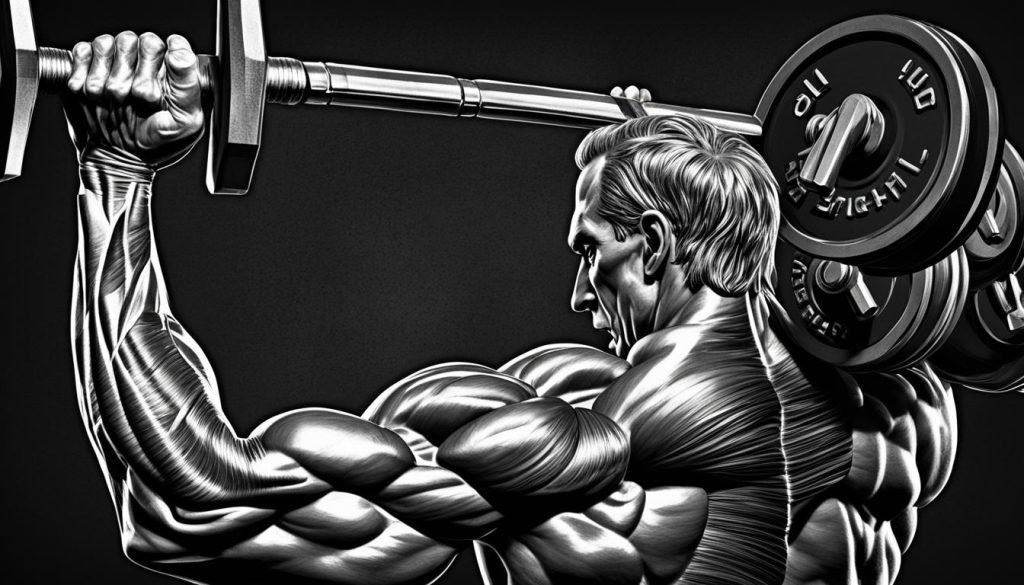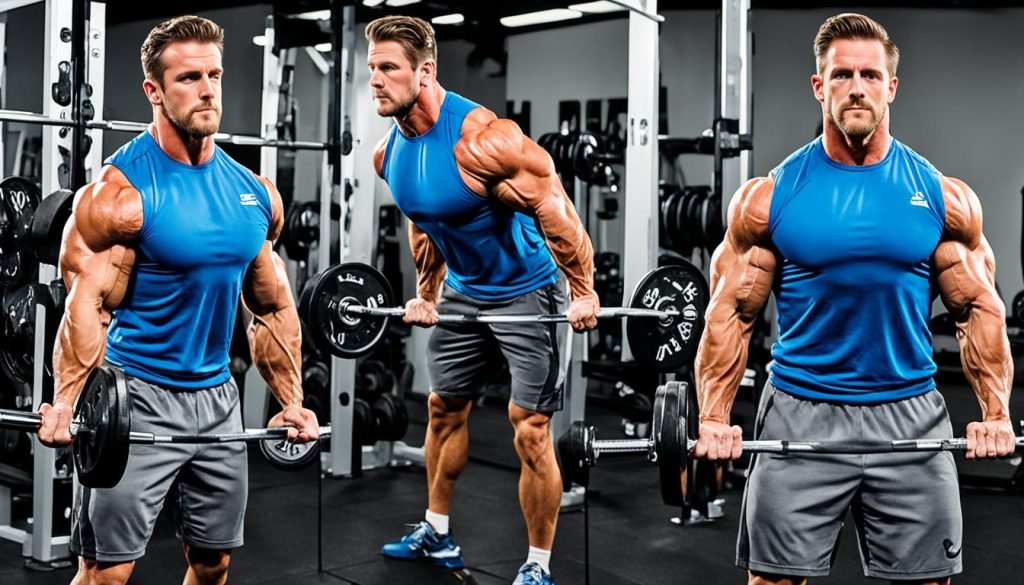Ever wondered why the barbell bicep curl is key for building strong arms? It's a top exercise for targeting muscles for growth. Unlike other curls, it focuses on the biceps brachii, helping you see big gains. Knowing which muscles this exercise works is key to improving your arm workouts.
Key Takeaways
- The barbell bicep curl primarily targets the biceps brachii for muscle growth.
- This exercise enhances grip strength essential for other lifting movements.
- Proper form is vital to prevent injuries and maximize results.
- Incorporating variations can help overcome plateaus in strength training.
- Increased arm strength can translate to better performance in pulling exercises.
Understanding the Barbell Bicep Curl
The barbell bicep curl is a key exercise for arm strength. It focuses on lifting to work the biceps alone. You stand with feet shoulder-width apart and hold the barbell with palms up.
Keeping your core tight is important for this lift. It stops you from leaning back and lets the biceps do the work. As you bend your elbows, the barbell moves up towards your shoulders. It's key to focus on your biceps to make the most of it.
This exercise is a basic yet effective part of resistance training. It shows how important it is to be consistent to build muscle strength. Doing it right boosts the benefits of bicep exercises and improves arm fitness.
Muscles Targeted by Barbell Bicep Curls
The barbell bicep curl is a key exercise that highlights the strength and function of several arm muscles. It's important to know which muscles are worked to make workouts more effective. The main muscles targeted are the biceps brachii, brachialis, forearm muscles, and elbow flexors.
Biceps Brachii
The biceps brachii is a muscle at the front of the upper arm. It has two parts: the long and short heads. These parts work together to bend the elbow and add to the arms' look.
Brachialis
Underneath the biceps brachii, the brachialis is key for bending the elbow. It helps with the curling motion. Building this muscle can make the arms look bigger and more defined.
Forearm Muscles
The forearm muscles, especially the brachioradialis, keep the grip stable during curls. They help control the barbell's movement. This ensures the right muscles are worked without losing form.
Elbow Flexors
Elbow flexors, like the biceps brachii and brachialis, help with the curling action. Working these muscles well can boost strength and control in workouts.

Benefits of the Barbell Bicep Curl
The barbell bicep curl offers many benefits for upper body strength and looks. Adding it to your workout routine can lead to big improvements in several key areas.
Increased Arm Strength
Regularly doing the barbell bicep curl boosts arm strength. It targets the biceps, which are key for many upper body movements. This means you'll do better in exercises like bench presses and pull-ups.
Muscle Hypertrophy
The barbell bicep curl helps grow your muscles. By lifting heavier weights and doing more reps, you make your biceps grow bigger and more defined. Over time, you'll see your muscles get bigger and more noticeable.
Enhanced Grip Strength
Gripping the barbell during curls also makes your grip stronger. A strong grip is important for bicep curls and other weightlifting exercises. It helps you perform better in strength training and everyday tasks.
Proper Form for Barbell Bicep Curls
Getting the most out of barbell bicep curls means keeping the right form. Paying attention to how you stand and hold the barbell is key. This helps you lift effectively and stay safe.
Stance and Grip
Start with your feet shoulder-width apart for a stable base. This helps you control the lift better. Hold the barbell with your hands shoulder-width apart for stability. Engage your core to keep your back straight and avoid mistakes.
Movement Mechanics
Begin the curl with your elbows close to your body. This helps work your biceps better and stops you from leaning back. Focus on controlling the lift in both the up and down phases. Use your biceps to lift, not just your body.
Common Mistakes
- Excessive leaning back during the lift, which reduces biceps activation.
- Allowing elbows to drift forward, shifting tension away from the target muscles.
- Using weights that are too heavy, leading to compromised form and potential injury.
Mastering these elements ensures efficient workouts and lessens the chance of injury.

| Barbell Curl Mistakes | Effects | Corrective Actions |
|---|---|---|
| Leaning Back | Reduces bicep engagement | Focus on keeping a stable stance and core engagement |
| Elbows Drifting Forward | Shifts tension away from biceps | Maintain elbow position close to torso |
| Using Heavy Weights | Compromised form and increased injury risk | Select an appropriate weight to sustain proper form |
Variations of the Barbell Bicep Curl
The barbell bicep curl is a versatile exercise that can be adapted in various ways. Each variation offers unique benefits, helping to prevent boredom in training and push past plateaus. By incorporating different styles into your routine, you can ensure a comprehensive approach to arm training.
Standard Barbell Curl
The standard barbell curl is the classic method focusing on heavy loading of the biceps. It's crucial to execute this technique with a controlled tempo. This ensures you get the most out of the exercise while minimizing injury risk.
Seated Barbell Curl
The seated variation helps isolate the biceps by reducing body movement. It encourages strict form and keeps the muscle under tension throughout. Performing seated barbell curls helps focus on developing the bicep peak and ensures consistent muscle engagement.
Drag Curl
The drag curl is a less conventional approach where the elbows are pulled back behind the torso. This technique shifts emphasis toward the long head of the bicep. It’s a valuable addition to routines alongside standard barbell curls.
Eccentric Curls
Eccentric curls focus on the lowering phase of the exercise. This variation emphasizes muscular tension and can lead to greater muscle growth over time. By incorporating eccentric curls, you enhance both the strength and resilience of your biceps.
FAQ
What muscles are primarily worked during the barbell bicep curl?
The main muscles worked are the biceps brachii, including the long and short heads. The brachialis and forearm muscles also get a workout, helping to bend the elbow.
How do I perform a barbell bicep curl correctly?
Stand with your feet shoulder-width apart and hold the barbell with palms up. Keep your elbows near your body and engage your core. Don't lean back as you lift the barbell to your shoulders.
What are the benefits of including barbell bicep curls in my workout routine?
These curls boost arm strength, help grow your biceps, and improve grip strength. They're key for building overall arm strength and for everyday movements.
Can I incorporate different styles of curls into my arm training?
Yes, you can try different curls like the seated barbell curl, drag curl, and eccentric curls. These variations can help grow your biceps and prevent training plateaus.
What are common mistakes to avoid when performing barbell bicep curls?
Avoid leaning back too much, letting your elbows move forward, and using too much momentum. Focus on controlled lifts and lowering of the barbell to engage muscles safely and effectively.
How often should I perform barbell bicep curls for optimal results?
For the best results, do barbell bicep curls 1-3 times a week. Make sure to rest well between sessions to help your muscles recover and grow stronger.
Why is grip strength important in weight lifting exercises?
Grip strength is crucial for stabilizing the weight during lifts. It greatly affects your performance in various exercises and overall functional strength.
Source Links
- How to Do the Barbell Curl for Biceps Size and Strength | BarBend – https://barbend.com/barbell-curl/
- The Best Arm Exercises For Your Next Arm Workout – https://central.gymshark.com/article/the-six-best-arm-exercises
- How to Do Barbell Biceps Curls for Big Arms – https://www.menshealth.com/fitness/a42744729/barbell-curls/
Recent Posts
It's important to evaluate whether Beachbody On Demand continues to meet your fitness needs as we enter 2025. With a range of workout programs and nutrition plans, the platform claims to cater to...
Just like having a personal trainer at your fingertips, Beachbody On Demand offers you an extensive library of on-demand workout programs accessible anytime, anywhere. This service allows you to...

